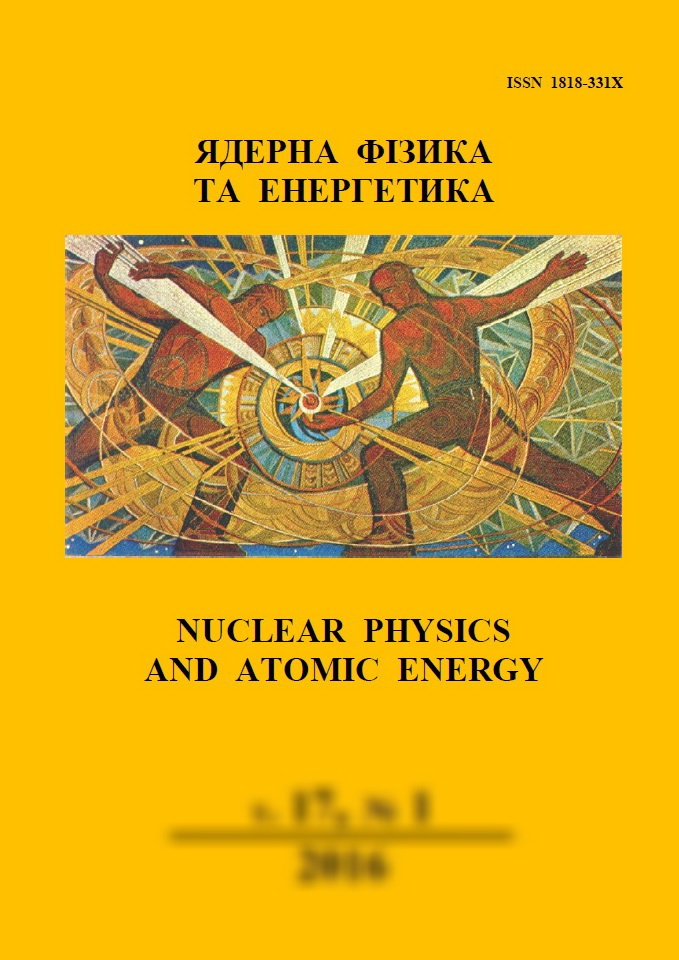 |
Ядерна фізика та енергетика
Nuclear Physics and Atomic Energy
ISSN:
1818-331X (Print), 2074-0565 (Online)
Publisher:
Institute for Nuclear Research of the National Academy of Sciences of Ukraine
Languages:
Ukrainian, English
Periodicity:
4 times per year
Open access peer reviewed journal
|
Nucl. Phys. At. Energy 2008, volume 9, issue 3, pages 39-44.
Section: Nuclear Physics.
Received: 09.06.2008; Published online: 30.12.2008.
 Full text (en)
Full text (en)
https://doi.org/10.15407/jnpae2008.03.039
Analysis of production of forward-angle fragments in the 22Ne (40 AMeV) + 9Be reaction
G. Kaminski1,2, A. G. Artyukh1, A. Budzanowski2, B. Erdemchimeg1,3, S. A. Klygin1, G. A. Kononenko1, E. Kozik2, T. I. Mikhailova1, Yu. M. Sereda1,4, Yu. G. Teterev1, M. Veselsky5, A. N. Vorontzov1,4
1Joint Institute for Nuclear Research, Dubna, Moscow Region, Russia
2Institute of Nuclear Physics PAN, Krakow, Poland
3Mongolian National University, Nuclear Research Center, Ulan-Baator, Mongolia
4Institute for Nuclear Research, National Academy of Sciences of Ukraine, Kyiv, Ukraine
5Institute of Physics, Slovak Academy of Sciences, Bratislava, Slovakia
Abstract:
A mechanisms of production of forward-emitted fragments in the 22Ne (40 АMeV) + 9Be reaction are investigated.
Inclusive velocity and isotopic distributions of products with 3 ≤ Z ≤ 11 were measured on the fragment separator
COMBAS. The contribution of direct processes and dissipative ones is presented. Gaussian fitting functions according
to Goldhaber formalism has been used to estimate direct components of fragments velocity distributions. Experimental
data have been compared to geometric incomplete fusion model predictions. Incomplete fusion model was the first time
applied for light nuclei as in the studied reaction system. Overall agreement of simulations with experiment in
description of velocity distributions have been achieved for fragments with atomic number close to the projectile mass
and for stable isotopes. Discrepancies for other products are the result of transition from incomplete fusion to direct
processes with collisions of clusters in the participant zone.
References:
1. Gregoire C., Tamain B. Intermediate energy heavy ion
reactions. Ann. Phys. Fr. 11 (1986) 323.
https://doi.org/10.1051/anphys:01986001104032300
2. Fuchs H., Moring K. Heavy-ion break-up processes in
the Fermi energy range. Rep. Prog. Phys. 57 (1994) 231.
https://doi.org/10.1088/0034-4885/57/3/001
3. Dayras R., Pagano A., Barrette J. et al. Peripheral
interactions for 44 MeV/u 49Ar on 27Al and natTi Targets. Nucl. Phys. A 460 (1986) 299.
https://doi.org/10.1016/0375-9474(86)90128-4
4. Faure-Ramstein B., Auger F., Wieleczko J. P. et al. Nucl. Phys. A 586 (1995) 533.
https://doi.org/10.1016/0375-9474(94)00796-P
5. Hanold K. A., Bazin D., Mohar M. F. et al. Heavy
residues from very mass-asymmetric heavy-ion
reactions. Phys. Rev. C 52 (1995) 1462.
https://doi.org/10.1103/PhysRevC.52.1462
6. Notani M., Sakurai H., Aoi N. et al. Projectile
fragmentation reactions and production of nuclei near
the neutron drip line. Phys. Rev. C 76 (2007) 044605.
https://doi.org/10.1103/PhysRevC.76.044605
7. Souliotis G. A., Morrissey D. J., Orr N. A. et al. 0°
measurements of momentum distributions of
projectile-like fragments. Phys. Rev. C 46 (1992) 1383.
https://doi.org/10.1103/PhysRevC.46.1383
8. Pfaff R., Morrissey D. J., Fauerbach M. et al.
Projectilelike fragment momentum distributions from
86Kr + Al at 70 MeV/nucleon. Phys. Rev. C 51 (1995) 1348.
https://doi.org/10.1103/PhysRevC.51.1348
9. Artukh A. G., Budzanowski A., Kamiński G. et al.
QMD approach in description of the 18O + 9Be and 18O + 181Ta reactions at Eproj = 35 AMeV. Acta Phys. Pol. B 37 (2006) 1875.
10. Mikhailova T., Colonna M., Di Toro M. et al.
Investigations of dissipative collisions with transport
models. Rom. Journ. Phys. 32 (2007) 875.
11. Goldhaber A. S. Statistical model of fragmentation
processes. Phys. Lett. B 53 (1974) 306.
https://doi.org/10.1016/0370-2693(74)90388-8
12. Veselsky M. Production mechanism of hot nuclei in
violent collisions in the Fermi energy domain. Nucl.
Phys. A 705 (2002) 193.
https://doi.org/10.1016/S0375-9474(02)00596-1
13. Artukh A. G., Gridniev G. F., Grushezki M. et al. Wide
aperture separator COMBAS realized on the strong
focusing principle. Nucl. Instr. Meth. A 426 (1999) 605.
https://doi.org/10.1016/S0168-9002(98)01383-7
14. Tassan-Got L., Stefan C. Nucl. Phys. A 524 (1991) 121.
https://doi.org/10.1016/0375-9474(91)90019-3
15. Von Oertzen W., Freer M., Kanada-En'yo Y. Nuclear
clusters and nuclear molecules. Phys. Rep. 432 (2006) 43.
https://doi.org/10.1016/j.physrep.2006.07.001
16. Veselsky M., Souliotis G. A., Chubarian G. et al.
Heavy residues with A < 90 from the asymmetric
reaction of 20 AMeV 124Sn + 27Al as a sensitive probe
of the onset of multifragmentation. Nucl. Phys. A 724 (2003) 431.
https://doi.org/10.1016/S0375-9474(03)01571-9
17. Veselsky M., Souliotis G. A. Production of cold
fragments in nucleus-nucleus collisions in the Fermi-energy domain. Nucl. Phys. A 781 (2007) 521.
https://doi.org/10.1016/j.nuclphysa.2006.11.019
18. Bondorf J. P., Botvina A. S., Iljinov A. S. et al.
Statistical multifragmentation of nuclei. Phys. Rep. 257 (1995) 133.
https://doi.org/10.1016/0370-1573(94)00097-M
19. Botvina A. S., Iljinov A. S., Mishustin I. N. et al.
Statistical simulation of the break-up of highly excited
nuclei. Nucl. Phys. A 475 (1987) 663.
https://doi.org/10.1016/0375-9474(87)90232-6
20. Lahmer W., Oertzen von W., Miczaika A. et al.
Transfer and fragmentation reactions of 14N at
60 MeV/u. Z. Phys. A 337 (1990) 425.
https://doi.org/10.1007/BF01294980
